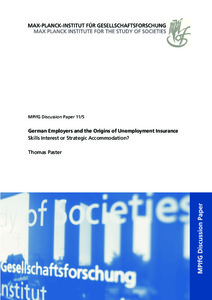German employers and the origins of unemployment insurance. Skills interest or strategic accomodation?
"This paper analyzes the attitudes of industrial employers during the German Empire and the Weimar Republic towards the adoption of public unemployment insurance. While employers initially opposed unemployment insurance, they eventually endorsed it. What explains this shift in attitude? The pap...
| Main Author: | |
|---|---|
| Institution: | ETUI-European Trade Union Institute |
| Format: | TEXT |
| Language: | English |
| Published: |
Köln
2011
MPIfG |
| Subjects: | |
| Online Access: | https://www.labourline.org/KENTIKA-19177502124919957849-German-employers-and-the-origi.htm |
| Summary: | "This paper analyzes the attitudes of industrial employers during the German Empire and the Weimar Republic towards the adoption of public unemployment insurance. While employers initially opposed unemployment insurance, they eventually endorsed it. What explains this shift in attitude? The paper tests two alternative theses: the conventional power resource thesis and the newer skills interest thesis. While the power resource thesis explains social protection as the result of distributive confl icts between employers and labor, the skills interest thesis sees it as an outcome of joint interests in skills investment by capital and labor. The study concludes that the power resource thesis has the greater explanatory power. Employers' support of unemployment insurance was an attempt to defeat other policy options on the agenda rather than an effort to promote skills investment. An unfavorable policy legacy and a sustained change in political majorities are the main factors that explain the change in positions. Fear of rising labor costs and the erosion of work incentives shaped employers' preferences rather than an interest in protecting skills investments. On a more general level, the results show the signifi cant impact of political constraints on the positions actors take and the importance of short-term considerations in processes of preference formation." |
|---|---|
| Physical Description: | 32 p. Digital |

